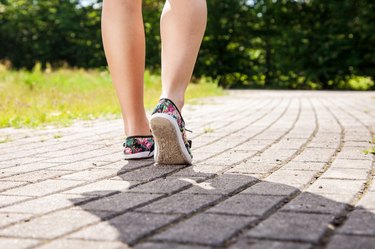
Sciatic nerve pain is literally a pain in the butt. This large nerve can become easily impinged, resulting in debilitating pain and physical limitations. The sciatic nerve runs from the lumbar spine in your low back, through muscles in your buttock and down the back of your leg. With proper form, walking can be beneficial for sciatica.
Tip
Walking with proper form can help reduce sciatic nerve pain.
Video of the Day
Understand Your Sciatica
The sciatic nerve can be irritated by a number of conditions, with some occurring near the spine and others further along the nerve. Arthritis of the spine and protruding discs between your vertebrae can lead to sciatica. The sciatic nerve can also be pinched by a muscle in the buttock called the piriformis.
Video of the Day
Irritation of the sciatic nerve can occur immediately after activity or might come on slowly. Sciatica can cause both sharp pain and aching that travel along the back of your leg. In fact, you might even experience sciatica pain in your calf when walking.
Sciatica typically only affects one leg, but in rare cases, compression of nerves at the bottom of the spinal cord can lead to bilateral sciatica. This condition is known as neurogenic claudication and can be brought on by walking.
Read more: Natural Foods that Heal Sciatica
Walking With Sciatica
High-impact exercises, such as sprinting or high-intensity interval training, should be avoided with sciatica. Walking is a low-impact exercise that is usually safe with sciatica. As an extra precaution, Spine-Health offers two tips to help you avoid further irritating the sciatic nerve while you're walking: a shorter stride and use of your core.
Stride length refers to the size of your steps when walking. Taking longer steps puts more stretch on your lower back and the back of your leg, which can increase stress on your sciatic nerve. Walking slower and consciously taking smaller steps can help shorten your stride.
The sciatic nerve branches off nerves in your lower spine. While walking, your spine has to work hard to keep your torso upright, which can increase pressure on these nerves. Stand up tall and tighten your abs while walking to reduce overall pressure on your spine.
Read more: Exercises that Aggravate Sciatica
Weakness From Sciatica
Prolonged compression on a nerve can lead to weakness in muscles supplied by that nerve. Sciatica can lead to weakness in the ankle, making it difficult to lift your toes off the ground when walking. This can impair your balance and increase your risk of falls, possibly making walking unsafe.
Walking in a pool can be safer if you have weakness. However, less than 50 percent of people with sciatica experience weakness.
Other Sciatica Interventions
Although walking is generally safe, other specific exercise recommendations vary based on the underlying cause of your sciatica. Exercises that help one person might make another person's sciatica worse. An accurate diagnosis can help.
A doctor might order imaging, such as an X-ray or MRI, to determine the underlying cause of your nerve compression and sciatic pain. A physical therapist can then design an individualized treatment program for you.
Read more: Sciatica Stretching Exercises
Is this an emergency? If you are experiencing serious medical symptoms, please see the National Library of Medicine’s list of signs you need emergency medical attention or call 911.